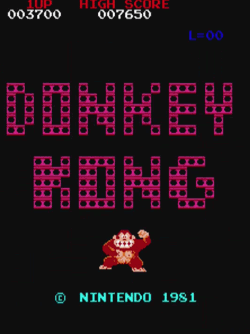 In 1981, Donkey Kong was released in arcades. This joint effort of Shigeru Miyamoto and Gunpei Yokoi was the first videogame to feature Mario, Pauline, and the titular Donkey Kong. It was also a pretty amazing way to spend a quarter or two. Donkey Kong resonated with many an arcade gamer, and became a success that wrote Nintendo, and its biggest stars, inexorably into the book of videogame history.
In 1981, Donkey Kong was released in arcades. This joint effort of Shigeru Miyamoto and Gunpei Yokoi was the first videogame to feature Mario, Pauline, and the titular Donkey Kong. It was also a pretty amazing way to spend a quarter or two. Donkey Kong resonated with many an arcade gamer, and became a success that wrote Nintendo, and its biggest stars, inexorably into the book of videogame history.
But damned if I have any idea why this game is any good.
Look, I’m not stupid. I know Donkey Kong came out in an era when a game having two whole stages (left alone four) was revolutionary. Nearly everything about Donkey Kong was ahead of its time in 1981, and it transformed gaming with something as simple as jumping. But here’s the thing: people still play Donkey Kong today. I still play Donkey Kong today. It’s fun! I like it! And I have no idea why! I could be playing any game on the planet that has dropped in the intervening (nearly) forty years, yet I still get excited when Donkey Kong Arcade is released for the Nintendo Switch. Why? I demand answers!
My first thought is…
Jump Man Jumps
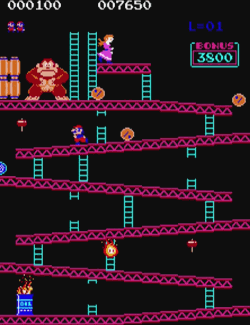 According to some sources, Donkey Kong is the first game to have a dedicated jump button. This seems insane, as, Jesus, what did games even do before a jump button? Was every videogame some variation on the absolute worst stages from Super Mario Maker 2? Or did some manner of Bionic Commando star in these adventures? I don’t want to live in a world where jumping is forbidden!
According to some sources, Donkey Kong is the first game to have a dedicated jump button. This seems insane, as, Jesus, what did games even do before a jump button? Was every videogame some variation on the absolute worst stages from Super Mario Maker 2? Or did some manner of Bionic Commando star in these adventures? I don’t want to live in a world where jumping is forbidden!
But the thing about Mario’s virgin jumps is that, unfortunately, they absolutely suck. Don’t get me wrong, I admire a man that can effortlessly leap over a rolling barrel (I, unfortunately, barely have the physical acumen to vault a rolling pickle jar), but Mario’s jumps are massive failures in every other scenario. Want to see Mario jump from a high elevator to a lower platform? Instant death. Need to make it over a girder gap and a mobile fire duck in the same bound? Burned to a crisp. Mario’s jumps are really only effective on barrels and the occasional pie, and they’re a far cry from the joy of motion Mario would eventually experience. Mario’s Donkey Kong jumps are, at best, simply utilitarian.
For the Sequel
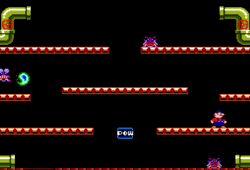 You ever wonder if Nintendo itself had any idea why Donkey Kong was successful? Given DK’s sequels, my personal theory has always been a resounding “no”. At best, it seems like Mario’s sad ups from Donkey Kong were repurposed into amazing leaps for the Mario Bros. series. The Mario of Mario Bros. lives in a very different world than his Jump Man ancestor, and it requires a man that can rise nearly a story in height on a routine basis. Later games took Mario’s jumps a step further by making them dangerous not just through his brick busting dome, but also through the raw stomping power of his magnificent boots. Jumping on things is what Mario is all about, and it seems like that was wholly codified by about the time they were cracking wise about it on the Super Nintendo.
You ever wonder if Nintendo itself had any idea why Donkey Kong was successful? Given DK’s sequels, my personal theory has always been a resounding “no”. At best, it seems like Mario’s sad ups from Donkey Kong were repurposed into amazing leaps for the Mario Bros. series. The Mario of Mario Bros. lives in a very different world than his Jump Man ancestor, and it requires a man that can rise nearly a story in height on a routine basis. Later games took Mario’s jumps a step further by making them dangerous not just through his brick busting dome, but also through the raw stomping power of his magnificent boots. Jumping on things is what Mario is all about, and it seems like that was wholly codified by about the time they were cracking wise about it on the Super Nintendo.
Yes, it seems that if Nintendo wanted to carry one thing forward from Donkey Kong, it was that Mario could jump, and that is apparently a lethal weapon.
Restraint is Key
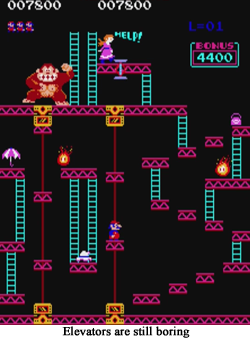 But even if future Mario titles expanded on Mario’s jumps, Mario’s Donkey Kong mobility is still pretty terrible. But maybe it’s deliberately terrible! Momentum is a huge part of any Mario title, and Mario’s lack of acrobatic prowess is supposed to be part of the fun. Mario is a very limited man that is just doing his best to rescue his princess du jour, so it makes sense that he can barely leap off an elevator without a trip to the hospital (and you know his insurance isn’t going to cover acts of Kong). It is important that Mario has a little weight to his jumps, and that his actions have consequences. It’s the restrictions that make Donkey Kong fun.
But even if future Mario titles expanded on Mario’s jumps, Mario’s Donkey Kong mobility is still pretty terrible. But maybe it’s deliberately terrible! Momentum is a huge part of any Mario title, and Mario’s lack of acrobatic prowess is supposed to be part of the fun. Mario is a very limited man that is just doing his best to rescue his princess du jour, so it makes sense that he can barely leap off an elevator without a trip to the hospital (and you know his insurance isn’t going to cover acts of Kong). It is important that Mario has a little weight to his jumps, and that his actions have consequences. It’s the restrictions that make Donkey Kong fun.
For the Sequel
Mario may have become a villain for Donkey Kong Jr., but the titular Donkey Kong Jr. inherited Mario’s fragility. DKJ is a mighty ape, but attempting to use a spring in the wrong place, or dropping off the wrong vine will lead to a very painful reminder of an ape’s mortality. Someone decided that short jumps and 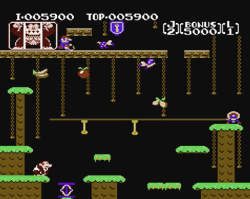 flimsy heroes were the essence of the Donkey Kong experience, so future games directly based on Donkey Kong carried that thinking forward for decades. Mario vs. Donkey Kong still features a Mario that earns a concussion after every missed jump. And is that any fun? Well, your mileage may vary, but I’d still prefer a Mario that can successfully leap out of black holes, and not an average joe that can barely survive broken knees.
flimsy heroes were the essence of the Donkey Kong experience, so future games directly based on Donkey Kong carried that thinking forward for decades. Mario vs. Donkey Kong still features a Mario that earns a concussion after every missed jump. And is that any fun? Well, your mileage may vary, but I’d still prefer a Mario that can successfully leap out of black holes, and not an average joe that can barely survive broken knees.
Power is the Key
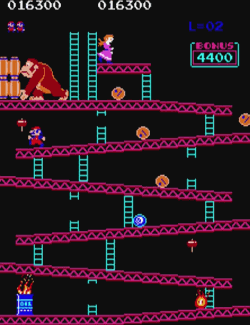 Boundaries suck. But you know what doesn’t suck? Breaking barriers and going hog wild on your enemies. The hammer powerup is the Pac-Man-esque route to not only achieving victory, but also having a good time. It may not appear in every level (because, let’s face it, it would be completely useless for overcoming an elevator), but the hammer is the great equalizer of the Donkey Kong universe. Grab that hunk of lumber and rubber (I assume?), and the barrels that menaced Mario for so long are now a direct path to points galore. Even fire means nothing to a hammer! Sure, you’re not completely invincible to threats, and you lose the ability to jump (there’s those restrictions again), but, dammit, it always feels good to turn the tables on that stupid gorilla.
Boundaries suck. But you know what doesn’t suck? Breaking barriers and going hog wild on your enemies. The hammer powerup is the Pac-Man-esque route to not only achieving victory, but also having a good time. It may not appear in every level (because, let’s face it, it would be completely useless for overcoming an elevator), but the hammer is the great equalizer of the Donkey Kong universe. Grab that hunk of lumber and rubber (I assume?), and the barrels that menaced Mario for so long are now a direct path to points galore. Even fire means nothing to a hammer! Sure, you’re not completely invincible to threats, and you lose the ability to jump (there’s those restrictions again), but, dammit, it always feels good to turn the tables on that stupid gorilla.
For the Sequel
 “Powerups” became another staple of the Mario franchise, complete with a Star Man that granted Mario the invincibility to feel like he was wielding his favorite hammer all over again. But in Donkey Kong Jr.? Or Mario Bros? Not a single powerup to be found. A powerup of sorts did return with DK being a villain again in Donkey Kong 3, where Stanley the Bug Man can occasionally earn an exterminating powerup that will tear through the big gorilla like an ape through a banana factory. It won’t last forever, but the return of an all-powerful tool in DK3 does feel a lot more empowering than DK Jr. and his silly fruit drops.
“Powerups” became another staple of the Mario franchise, complete with a Star Man that granted Mario the invincibility to feel like he was wielding his favorite hammer all over again. But in Donkey Kong Jr.? Or Mario Bros? Not a single powerup to be found. A powerup of sorts did return with DK being a villain again in Donkey Kong 3, where Stanley the Bug Man can occasionally earn an exterminating powerup that will tear through the big gorilla like an ape through a banana factory. It won’t last forever, but the return of an all-powerful tool in DK3 does feel a lot more empowering than DK Jr. and his silly fruit drops.
Let’s Collect Things!
 But maybe the way the hammer inflates your score is the real prize here. Donkey Kong stages are littered with Pauline’s missing items: a hat, a purse, and an umbrella. Can Mario collect ‘em all? Can you? Well you damn well better if you want to say you’re the best Donkey Kong’er out there! This additional, optional challenge is perfect for the player that claims they’ve done everything the game has to offer, and it seems only appropriate that such an enduring game has more to its levels than initially meets the eye.
But maybe the way the hammer inflates your score is the real prize here. Donkey Kong stages are littered with Pauline’s missing items: a hat, a purse, and an umbrella. Can Mario collect ‘em all? Can you? Well you damn well better if you want to say you’re the best Donkey Kong’er out there! This additional, optional challenge is perfect for the player that claims they’ve done everything the game has to offer, and it seems only appropriate that such an enduring game has more to its levels than initially meets the eye.
For the Sequel
Getting a coin or two used to be all Mario needed in his life, but the late nineties exposed how Mario has been a compulsive collector since he was a baby. Ever since that reveal, it seems like every Mario title has reveled in collecting stars, shines, and the occasional thousand or so moons. Mario no longer 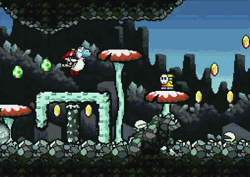 enters levels, he only sees his worlds as a series of locations with different doodads and trinkets to collect. And, yes, it all started back in the day when he was grabbing accessories for Pauline. It may have taken a few games of collecting spare change for him to get his groove back, but later Mario titles are practically defined by their collectibles.
enters levels, he only sees his worlds as a series of locations with different doodads and trinkets to collect. And, yes, it all started back in the day when he was grabbing accessories for Pauline. It may have taken a few games of collecting spare change for him to get his groove back, but later Mario titles are practically defined by their collectibles.
It’s All About the Spectacle
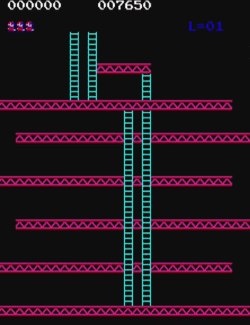 It’s easy to discount it all now, but Donkey Kong is also a surprisingly cinematic game. The opening invasion of Donkey Kong is very straightforward, and his impact on a local construction site explains the initial level design. And, while we might not have a clear account of why a gorilla would invade a pie factory or elevator/jack store (?), we do know the end result of his evil deeds is a rapid trip to the bottom compliments of Mario’s quick thinking. Bowser barely got wiggly toes for his first defeat, but Donkey Kong’s descent is memorable and ends with a kiss. Sure, it all precedes everything happening again for on a nigh-infinite loop, but it’s still a fun end for a fun game. Maybe the most important aspect of a game is its charm point.
It’s easy to discount it all now, but Donkey Kong is also a surprisingly cinematic game. The opening invasion of Donkey Kong is very straightforward, and his impact on a local construction site explains the initial level design. And, while we might not have a clear account of why a gorilla would invade a pie factory or elevator/jack store (?), we do know the end result of his evil deeds is a rapid trip to the bottom compliments of Mario’s quick thinking. Bowser barely got wiggly toes for his first defeat, but Donkey Kong’s descent is memorable and ends with a kiss. Sure, it all precedes everything happening again for on a nigh-infinite loop, but it’s still a fun end for a fun game. Maybe the most important aspect of a game is its charm point.
For the Sequel
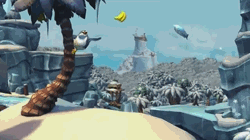 Maybe the NES just didn’t need much of an attract mode, but it seems like Nintendo didn’t return to the realm of big monkey spectacle until Donkey Kong Country. But let me tell you, once those pre-rendered chimps started running around the screen again, we were never going back to a mundane Donkey Kong ever again. DK has become one of the most animated characters in the Nintendo pantheon, and whether it’s because he’s mostly mute or monkeys just lend themselves to exaggerated actions, this Kong is back in the spectacle sphere. I can’t think of any other Nintendo hero or villain more likely to kick it to swing music and belt out an autobiographical rap.
Maybe the NES just didn’t need much of an attract mode, but it seems like Nintendo didn’t return to the realm of big monkey spectacle until Donkey Kong Country. But let me tell you, once those pre-rendered chimps started running around the screen again, we were never going back to a mundane Donkey Kong ever again. DK has become one of the most animated characters in the Nintendo pantheon, and whether it’s because he’s mostly mute or monkeys just lend themselves to exaggerated actions, this Kong is back in the spectacle sphere. I can’t think of any other Nintendo hero or villain more likely to kick it to swing music and belt out an autobiographical rap.
So Why Play Donkey Kong?
Hmmm… playing Donkey Kong and its many Nintendo descendants has brought one thing to my attention…
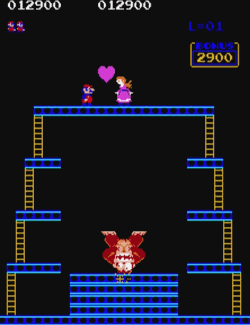
Mario…
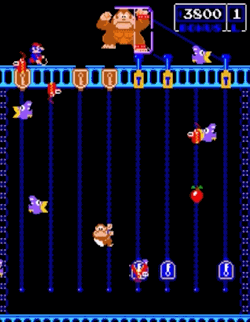
Is…
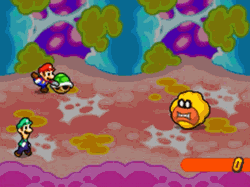
A…
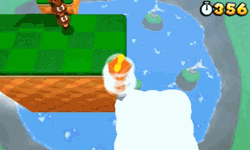
Sadist.
Wanton cruelty? That’s why I play Donkey Kong and its many sequels? Hm. Can’t really argue with the evidence.
Sorry, guys. Sometimes the right answer isn’t always the nice one.
FGC #470 Donkey Kong
- System: Arcade, Nintendo Entertainment System, Nintendo Switch, N64 Donkey Kong Unlockable, E-Reader, Animal Crossing, etc. It gets around. For the record, Random ROB technically chose the NES version that includes Donkey Kong Jr.
- Number of players: Has anyone ever figured out what 2-Player B Type is all about? Can Mario Punch another Mario?
- Favorite Stage: I’ve always been a fan of 100m, as defeating Donkey Kong is satisfying, and nothing beats a level bathed in sentient flames. Also, the final challenge is appropriately crowded in the arcade version.
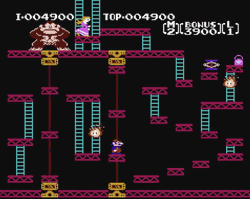 Speaking of crowded: You lose it on the NES, but a number of Arcade Donkey Kong stages can get very overpopulated with enemies as the stages progress. And then Donkey Kong Jr. has its “final level” with an endless number of birds that practically turn the game into a bullet hell situation. Frankly, when you look at some of these challenges, it’s no wonder that Donkey Kong 3 became a shoot ‘em up.
Speaking of crowded: You lose it on the NES, but a number of Arcade Donkey Kong stages can get very overpopulated with enemies as the stages progress. And then Donkey Kong Jr. has its “final level” with an endless number of birds that practically turn the game into a bullet hell situation. Frankly, when you look at some of these challenges, it’s no wonder that Donkey Kong 3 became a shoot ‘em up.- Save Your Fork, There’s Pie? Okay, the cut level from Donkey Kong Arcade, 50m, is actually supposed to still be a factory area, and there are tubs of cement that are conveying around to cause Mario’s death. So Mario is not allergic to pie, he’s simply being drowned in cement. That make enough sense to everybody?
- Did you know? Donkey Kong 64 is a poor way to play any Donkey Kong title, left alone the only legal way to play the complete arcade version at home for decades. Real Donkey Kong’s paw situation there.
- Would I play again: I legitimately have no idea why I enjoy Donkey Kong, but I do enjoy playing it every once in a while. It’s not my favorite by any means, but it’s always good for a quarter or two. Bless you, you crazy monkey.
What’s next? Random ROB has chosen… Teenage Mutant Ninja Turtles: Turtles in Time! Cowabunga! Please look forward to it!
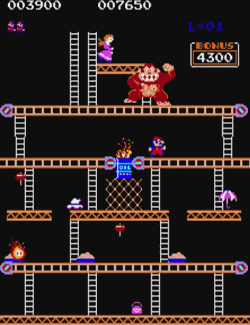
They’ll always be pies to me
For me, a big part of Donkey Kong’s appeal is that it’s a game that’s competent at what it does that’s also pretty short. When I replay Super Mario Bros. I feel like I have to commit to an entire 32 levels, but with Donkey Kong or Jr. I’m content with managing to finish a three-to-four stage* run. Naturally, I’m more likely to replay it because it’s less of a time commitment.
On the subject of arcade games, I find it fascinating that Nintendo made not one, but two Joust clones. Mario Bros. is basically Joust with a more grounded protagonist and Balloon Fight is Joust with different level designs.**
Back on Donkey Kong, it’s my belief that the 1994 Game Boy title’s more mobile Mario was a big inspiration for the Super Mario 64 team. I mean, 64 Mario ain’t handstanding or launching himself from wires, but the backflip and triple jump originated there. Whether you love or hate the puzzle stages, movement was fun in DK94, and making movement fun was also a priority for Super Mario 64.
* I play the Japanese arcade versions because I do not like having to git gud (well, git guder) if I ever want to see the second stage. Withholding stages for the second and third runs was just mean.
** Also the arcade version had vertical stages taking up two screen’s worth of retail (YMMV on whether this makes them better or worse than NES) and the console version added the ever popular Balloon Trip mode.
[…] Mario has always been rewarded for his bloodlust. In Mario’s first appearance, leaping over a barrel would award 100 points, but smashing and bashing with a hammer granted […]
[…] playing Donkey Kong? Pac-Man? Space Invaders? Remember beating those games? Yes? Liar! You may have dropped DK from the […]
[…] that he saw Pac-Land as stiff competition for his already successful (but undoubtedly waning) Donkey Kong. And he had a 2-D side scroller already in mind for Jump Man, but Pac-Land had something he had not […]
[…] the beginning, there was Super Mario Bros., and it was good. Donkey Kong and (Regular) Mario Bros. were curiosities, but OG SMB was like nothing ever seen before. No more […]
[…] of a feature within a franchise. Mario games are similar, as it’s very difficult to see Donkey Kong existing in even the same universe as Super Mario Odyssey (and not just because Bowser got bored […]
[…] to helicoptering into a mall “sanctuary”. And, to be absolutely clear, that’s perfectly fine! Donkey Kong is legally distinct from King Kong, and Dead Rising is allowed to liberally borrow a few elements […]
[…] Donkey Kong had Donkey Kong, and that was all we needed. Super Mario Bros. had the same Bowser at the end of every world/castle, but a troop hierarchy was established by the various monsters that were revealed to be disguising themselves as the big guy. Only upon conquering World 8 did you truly defeat the giant turtle responsible for everything. Super Mario Bros. 2 Japan (The Lost Levels) pulled a similar trick, though did throw a few Blue Bowsers into the mix. Super Mario Bros. 2/Doki Doki Panic, though, did try at memorable bosses. Wart was the leader, and his minions presiding over the various fortresses would never be mistaken for the lesser creatures that populated every other area. Triclyde, Mouser, Fryguy, and Claw Grip were the baddies to beat, and they felt like complete threats with multiple heads or sunglasses doing the heavy lifting of defining a personality. And that was a good start! But Mario needed bosses just as iconic as a koopa troopa or goomba… […]